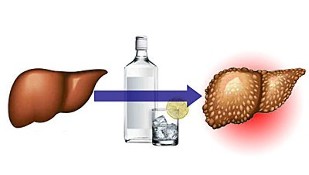The most famous consequence of alcohol consumption is liver disease. There are many myths about the lesser dangers of drinking vodka, beer, or wine. All alcoholic beverages contain ethanol, a potentially toxic substance, so there are no small or beneficial doses.
The negative consequences of alcohol consumption are also possible in small doses, but over a longer period of time.
Why is alcohol harmful to health?
If alcohol is consumed frequently and excessively, it can not only lead to addiction but also be the cause of many organic diseases. Ethanol itself and its components, which occur in the manufacture of alcoholic beverages, can be harmful to health.
The following organs are most commonly affected:
- liver (alcoholic liver steatosis, hepatitis, liver cirrhosis);
- stomach (peptic ulcer, dyspepsia);
- Colon (colon cancer);
- pancreas (pancreatitis).
Alcohol is highly toxic and addicting. This is why it is so difficult for many to stop drinking immediately without any consequences. The lethal dose of ethanol is around 8 g per 1 kg of body weight. Therefore, when drinking beer, vodka or drinks, it is necessary to remember the moderation of both the amount and frequency of consumption. Alcohol is a source of so-called empty calories. Consumption in large quantities leads to the development of obesity (1 g of ethanol-7 kcal).
Alcoholic beverages contribute to the development of various diseases and aggravate the symptoms of existing ones.
Therefore, it is worth drinking in small quantities. You can choose drinks that may be less harmful. You should also watch out for certain compounds that worsen the toxicity of ethanol. But even if these rules are followed, sooner or later the negative consequences of drinking will be felt.
What determines the harmfulness of alcohol?
The effects of alcohol on the body depend on various factors. What matters is the type and amount of ethanol consumed, gender, genetic factors, time and route of consumption, type of medication used, and overall health. Similarly, the effectiveness of alcoholism treatment depends.
The simultaneous consumption of alcohol and tobacco is extremely harmful to the body.
A strong connection between alcohol and development has been demonstrated:
- oral tumors;
- Neoplasms of the tonsils;
- Larynx cancer.

The risk of developing these tumors is increased by 30% for alcohol consumers. At this point, the risk increases when alcohol is combined with smoking cigarettes. Consuming alcohol and smoking cigarettes at the same time increases the risk of the negative effects of alcohol and severe hangover.
One of the most common mistakes in developing hangovers is drinking alcoholic beverages on an empty stomach. This speeds up the absorption of alcohol and leads to an increase in hangover symptoms the next day.
Different flavors, such as those used to make beverages and combine many types of alcoholic beverages, also contribute to the occurrence of a hangover. The smallest hangover occurs after consuming good quality vodkas.
Ethanol poisoning can also occur with alcohol abuse. The symptoms are:
- nausea and vomiting;
- dizziness;
- diarrhea;
- Dehydration.
Safe drinks - what does that mean?
Numerous scientific studies (from various centers around the world) report the beneficial effects of very small amounts of alcohol on the function of individual organs.
A small amount of alcohol contains between 20 and 40 grams of pure ethyl alcohol. We can roughly say that this is:
- is a small bottle of beer;
- a glass of wine;
- 40 ml vodka.
Recommendations should not be viewed as incentives to drink alcoholic beverages, much less regular daily consumption. It should be reminded of the negative consequences of alcohol consumption, even a small amount that can lead to drug addiction.
Many beer and wine drinkers can be tricked into examining what is known as the safe amount of alcohol.
A reasonable daily dose has been approved which, in theory, should not have any negative effects on the human body. For women, it is 20 g of alcohol per day, which corresponds to a small can of beer or a glass of wine. For men, 40 g of alcohol per day. These restrictions assume consumption of a maximum of five times a week. However, even these amounts can lead to addiction and serious health damage.
It should be noted that it is easier for a woman to become addicted to alcohol than it is for a man. They also have slower metabolic processes for alcohol withdrawal. When a woman consumes the same amount of alcohol, its concentration in the blood reaches a higher value than that of a man.
Can alcohol have a positive effect?
It doesn't matter what kind of alcohol each person drinks in what quantities. Regardless of whether this exceeds the safe dose or not, it can still lead to illness and drug addiction. They say it's never too late to stop drinking. The sooner you do it the better. This way you can avoid negative effects on the whole body.
Numerous studies have shown that small amounts of alcohol consumed every day increase the amount of so-called good HDL cholesterol. HDL particles work more positively than bad cholesterol (LDL). This is considered to be the only way to remove cholesterol that the body has
Here, too, it should be noted that the role of alcohol is an exception and is only used in very small doses. Small amounts of alcohol do not affect total cholesterol. According to research data, on the contrary, excessive alcohol consumption leads to an increase in the parameters of the amount of cholesterol.
You can often read about the health benefits of drinking wine and beer. In fact, they contain some substances that can have beneficial effects on the body. For example, quercetin and resveratrol, found in red wine, have beneficial effects on the heart and vascular system. These are the so-called antioxidants.
However, other foods that are least safe are also a source of antioxidants: red grapes, berries, apples, nuts. The negative effects of alcohol consumption here are more than good.
How many calories and which ingredients do alcoholic beverages contain?
Wine contains 8. 5–18% ethanol. The calorie content of wine depends on its type. Sweet wines have the most calories (approx. 94-104 kcal per 100 g). A minimum of calories is provided by dry wine (65-68 kcal per 100 g). Wine includes including:
- flavonoids;
- tannins;
- organic acids;
- calcium;
- potassium;
- phosphorus;
- magnesium;
- hardware;
- Vitamins of group B.
Red, dry wine is one of the least harmful and low in calories and contains the most antioxidants. Although the content of many valuable compounds is quite high, wine is an alcoholic beverage that contains pure ethanol. This means that the negative consequences of alcohol consumption are also possible in this form.

The alcohol content in beer is very different - from 0. 2 to 9-10%. Beer of course has about 49 kcal per 100 g, dark beer on the other hand has more calories, because in 100 g about 68 kcal
Beer especially contains antioxidants and B vitamins, magnesium, potassium and phosphorus. Here you can find a lot of information about the positive effects of beer on the urinary tract. But beer is also a source of ethanol. There is a beneficial effect on the urinary system, but this does not outweigh the loss to the body.
High quality vodka, liqueurs and cognacs contain the largest amount of ethyl alcohol - from 15 to 80%. They are also very high in calories, vodka contains around 220 kcal per 100 g.
Regardless of what minimum doses of alcohol is consumed, it still has devastating effects on the entire body. Don't fall for false facts about the benefits of alcoholic beverages. Alcohol is definitely an unnecessary substance and sometimes dangerous to the functioning of organs and systems. Treatment of alcoholism is a very complex and often lengthy procedure that requires special efforts on the part of the patient, their relatives and the medical staff. The negative effects of alcohol consumption are far more serious than the fleeting pleasure of being drunk.


























